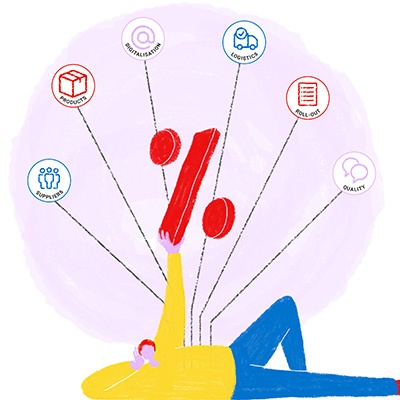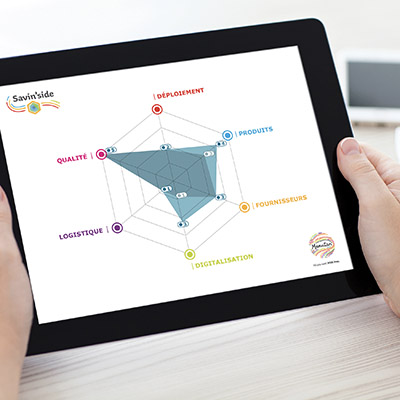The rapid development of generative artificial intelligence (AI) opens exciting perspectives for companies. However, these large language models require specific expertise to unlock their full potential: Prompt engineering. In other words, it’s the art of crafting effective queries. This is how AI can understand our intentions, follow our instructions, and deliver expected results. Today, prompt engineering has joined the list of essential new skills to master.
What is prompt engineering?
Prompt engineering consists of designing and optimising text prompts to guide generative AI models towards the best possible results. These prompts are detailed instructions provided to Natural Language Processing (NLP) models to perform specific tasks or generate specific responses.
The idea is to provide clear, precise and comprehensive directions to frame the results. However, they shouldn’t be overload with instructions that limit their creativity. Prompt engineering therefore strikes a delicate balance between guidance and autonomy: An effective prompt directly influences the quality and relevance of the outputs.
In essence, prompt engineering requires curiosity, adaptability and technological proficiency. These skills ensure precise, relevant and secure human-machine interactions. In some countries, it has even become a new profession, and they are called “prompt engineers”.
Prompt engineering techniques
There are various techniques for crafting prompts for generative AI tools like ChatGPT. Each has its own approach and function.
Direct queries
Zero-shot prompts are based on simple requests, supported by contextual elements. This can be formulated through a question or role assignment. In this case, the AI model hasn’t been explicitly trained to perform this task.
One-shot, few-shot and multi-shot prompts
One-shot prompts rely on a clear, descriptive example of the desired output. Few-shot and multi-shot prompts include even more examples. This technique is suitable for more complex tasks or when seeking a response following a specific structure that’s difficult to describe.
Chain-of-thought prompting
Chain-of-thought prompting encourages the model to explain its reasoning. In other words, to break down its task step by step. These can be combined with few-shot prompts to produce more accurate results when dealing with complex tasks that require reflection before responding.
3 steps for effective prompt engineering
To get the most out of generative AI, you need to know how to communicate with it through prompts. Remember that the more complete the prompt, the more precise and relevant AI’s response will be. Here are some best practices to remember when crafting effective prompts.
Being clear and precise
Use clear and simple language, providing all necessary details. This includes, for example:
- The role AI should adopt;
- The specific task to perform;
- The technique and/or source to use;
- The final objective, contextual elements;
- Response format;
- Target audience;
- Constraints…
To go even further, you can ask AI to pose additional questions before providing any response, ensuring the tool has perfectly understood the request.
Iterating and experimenting
Don’t hesitate to adjust your query as many times as necessary if you’re not satisfied with initial results. Persevere by trying different formulations, adjusting the level of detail, testing different query lengths…
It’s also necessary to integrate lifelong learning. The capabilities of AI tools evolve, as do user needs. This involves regularly updating your prompts.
Knowing the tool’s limitations
It’s imperative to always examine the responses provided by AI as they can be erroneous, obsolete or biased. It’s also important to ask the model to specify its sources or verify them through your own means. Lastly, a crucial point concerns data protection. That’s why you should never share any personal or critical information in prompts, even if it means anonymising certain key elements, depending on the type of tools. And as Ralph De Groot, founder of Procurement Tactics, emphasises: "AI can be very powerful in procurement just make sure to use it in the right way."
Prompt engineering applied to procurement
Through generative AI, procurement professionals can significantly facilitate their operations. It promises better analysis and decision-making, as well as productivity gains and cost optimisation.
According to the latest Deloitte survey, 92% of Chief Procurement Officers focused on planning and evaluating generative AI capabilities last year. However, only 37% were actually testing or deploying these tools. Among them, about 50% saw a return on investment (ROI) doubled compared to traditional methods, and some advanced implementations saw their ROI multiplied by more than five.
Today, use cases cover the entire Source-to-Pay process, from supplier research to contract management.
Supplier research
Generative artificial intelligence facilitates external data collection and analysis, enabling teams to identify new suppliers. Procurement teams can also use it to evaluate and compare different suppliers’ offers based on selected scenarios.
RFIs, RFPs and RFQs
With generative AI, buyers can automate the generation of Requests for Information, Proposals and Quotations (RFIs, RFPs and RFQs). It’s also possible to detect risks and errors in these documents, serving better compliance.
Contract management
Using these tools, procurement departments can draft compliant contracts, analyse existing contracts to detect potential risks, track deadlines, manage contract renewals…
The application possibilities don’t stop there. This also concerns all analytical work, whether it touches markets, procurement budgets or supplier performance and risks… This facilitates supplier relationship management and risk management. Lastly, AI supports the preparation of procurement requests, negotiations… In other words, the scope of application is extremely broad.
To effectively use prompt engineering, it’s essential that procurement teams master this technology. This initially requires that the company has implemented an artificial intelligence policy. This provides a safe framework for everyone to train, experiment and refine their knowledge. To get started, you can rely on prompt libraries made available by certain players or even ask AI models for help in writing the most suitable prompt.
Prompt engineering thus paves the way for increasingly precise, relevant and actionable results. For this, teams must better understand these tools’ capabilities and master quality prompt design. As such, it represents a fantastic lever for improving efficiency and strategic decision-making within companies.









